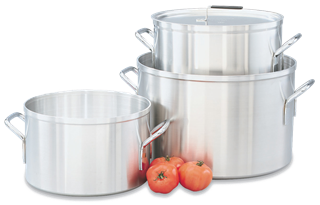Aluminum Basics

Aluminum is a silvery-white and ductile metal that is soft and easily formed. It's the most abundant metal in the Earth's crust and the third most abundant element overall. It makes up about 8% by weight of the Earth's solid surface. Aluminum is commonly used in the foodservice industry in cookware and bakeware and is a great conductor of heat.
Grades of Aluminum
It's important to have the correct grade/alloy to achieve the best results for each foodservice application. Let's take a look at a few grades that are commonly used in foodservice.
| Grade/Alloy | Description |
|---|---|
| 1100, 99% | Soft and forms easily. Can't withstand tough commercial-duty applications or high heat without warping. Items made of this material dent and scratch easily. |
| 3003, 1 to 1.5% manganese | Easily formed. Items of this material typically hold up extremely well during normal use. Works best in low- to medium-volume commercial kitchens. |
| 3004, 1 to 1.5% manganese and about 1% magnesium | More difficult to form than 1100 or 3003. Much more impervious to severe use, and tougher and longer-lasting than 3003. 3004 is used for quality cookware, bakeware, and tougher commercial equipment applications. |
Benefits of Aluminum

NON-CORROSIVE: Like stainless steel, aluminum has a higher resistance to oxidation and corrosion due to passivation.
LIGHTWEIGHT AND STRONG: Unlike most other metals, aluminum is very light-weight and strong, particularly when blended with alloying elements. This is perfect for structural parts and equipment housings, as well as heavy-gauge cookware.
GREAT HEAT CONDUCTOR: Excellent thermal conductivity makes aluminum a good material for cookware and equipment where you need heat conductivity.
LOWER COST: This makes it a popular material for food service applications.
Applications
Aluminum is widely used in the china segment of the foodservice industry. It is used as an additive to raw materials to add strength to thin-wall finer china, providing durability without making it heavy or clunky. Aluminum works well since it melts at 1221 degrees F and fully vitrified china is kiln-baked between 1400 and 2200 degrees F.
Aluminum is also found in housings for larger foodservice equipment items such as slicers, mixers, and horizontal cutters/mixers. As previously mentioned, it is also common in pots, pans, and bakeware. Essentially, aluminum is used anywhere in the foodservice industry where a strong, light, easily constructed material is needed. Since aluminum is a non-ferrous alloy, aluminum cookware cannot be used with induction cooking equipment, as this technology relies on ferrous magnetism to transmit heat.
Stainless vs Aluminum Differences
- Strength: Stainless Steel is a harder material and more difficult to form than aluminum.
- Weight: Stainless is much heavier than aluminum.
- Thermal Conductivity: Aluminum has much better thermal conductivity than stainless steel, providing even heat distribution.
- Price: Aluminum is generally less expensive than stainless steel.








